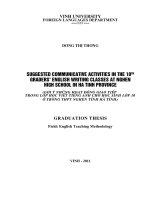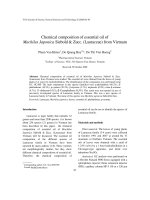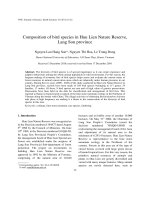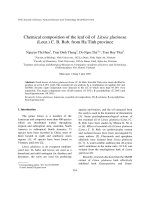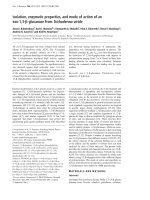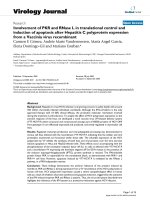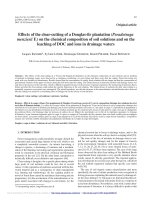Chemical composition of the leaf oil of Litsea glutinosa (Lour.) C. B.Rob. from Ha Tinh province
Bạn đang xem bản rút gọn của tài liệu. Xem và tải ngay bản đầy đủ của tài liệu tại đây (455.53 KB, 4 trang )
<span class='text_page_counter'>(1)</span><div class='page_container' data-page=1>
VNU Joumal of Science, Natural Sciences and Technolo gy 26 (2070) 161-7(/.
Chemical composition
of
the
leaf
oil
of
Litsea
glutinosa
(Lour.)
C.
B. Rob.
from
Ha Tinh province
Nguyen
Thi
Hienr, Tran
Dinh
<sub>rhang2,Do Ngoc Dai3,*, Tran Huy </sub>
<sub>Thai3</sub>'
tFaculty ofBiolog,
Yinh University, lB2 Le Duan, Vinh, Nghe An, vietnam2Faculty
of chemistry, vinh (Jniversity, 182 Le Duan, vinh, Nghe An, yietnam
3lnstitute
of Ecolog and Biological Resources, Vietnamese Academy of Science and Technologt,
18 <sub>Hoang Quoc </sub>Viet, Hanoi, Vietnam
Nh{n ngdy I th6ng 3 ndm 2010
Abstract. Fresh leaves of Litsea glutinosa (Lour.) C. B. Rob. from Ha Tinh were steam distilled to
produce an oil in 0'15% yield. The essential oil was analysis by a combination of capillary GC and
GCA4S. Seventy eight compowrds were detected in the oil, of which more than 95.18% were
terpenoids. The major components were (E)-p-ocimene (13.35%), p-caryophyllene (27.20%) and
bicyclogermacrene ( I 8. I 6%).
fyry
: Litsea glutinosa, <sub>Lauraceae, essential </sub><sub>oil </sub><sub>composition, (E)-p-ocimene, p-caryophyllene,</sub>bicyclogermacrene.
1. Introduction
The
genusLitsea
is a
memberof
theLauraceae and <sub>comprises more than 400 </sub><sub>species</sub>
which
are
distributed
widely
throughouthopical <sub>and subtropical Asia, Ausfialia, North</sub>
America
to
subtropical SouthAmerica;
73species <sub>have been recorded </sub>
<sub>in </sub>
<sub>China, </sub><sub>most </sub><sub>of</sub>
them located
in
south and southwest warmregions
<sub>[]; </sub>
a5
species have been found inVietnam, until now [2].
Litsea glutinosa
is
an evergreenmedium-sized tree.
Its
<sub>barks and leaves are used as </sub>ademulcent and mild astringent for diarrhea and
dysentery,
the
roots
are usedfor
poulticing;Co*rp*alng
author. Tel.: 84-38-3855697.
E-mail:
sprains and bruises, and the
oil
extracted fromthe seeds is used in the treatrnent of rheumatism
[3].
Some psychopharmacological actionsof
the essential
oil
of Litsea glutinosa (Lour.) C.B. Rob. have been studies by Menon
K. M.
etal. [a]. Effect of essential oil of Litsea glutinosa
(Lour.)
C.
B.
Rob.on
cardiovascular systemand isolated tissues <sub>have been investigated by</sub>
same authors
<sub>[5]. </sub>
Flavonoids and aporphinealkaloids were isolated from Litsea glutinosa
[6, 71.
A
water-soluble arabinoxylan (D-xyloseand L-arabinose in the molar ratio 1.0:3.4) was
isolated from the mucilaginous bark
of
Litseaglutinosa
<sub>l8l.</sub>
Recently, research disclosetl that the MeOH
extract
of
Litsea
glutinosabark
effectivelyinhibited
both
Gram-positive
and
</div>
<span class='text_page_counter'>(2)</span><div class='page_container' data-page=2>
162
N.T. Hien et al. I WU lournal of Science, Natural Sciences and Technology 26 (20L0) 1.61.-1.64negative bacteria.
The
results
justiff
thereported uses in diarrhea and dysentery <sub>[9].</sub>
The BuOH extract
of
the leaves and twigsof
Litsea
glutinosawere
shownto
exhibitsignificant
cytotoxic
activity
against humanHela cell lines.in vitro. Chemical examination
of the BuOH extract of the leaves and tvrigs
of
Litsea glutinosa collected from Xishuangbanna
resulted
in
the isolationof
two new aporphinealkaloids, namely litseglutine
A
andB,
alongwith
two
known aporphine alkaloids, boldineand <sub>laurolitsine [10].</sub>
In
the
courseof
the
systematic studyof
Litsea
in
Indochina,
monoterpenes,sesquiterpenes and other components of the leaf
oil
of Litsea glutinosafiom
Ha Tinh provincehave been investigated.
2.
Experimental
.
1. Soarce- Litsea glutinosa (Lour.)
C.
B.Rob. (Lauraceae),
is
a shrub tree upto 7-10'
high, growing in Vietram. The leaves of Litsea
glutinosa were collected
in April
2009;in
Vu,Quang National
park,
Ha Tinh
province.A'
voucher specimen
(NHll0)
was deposited atthe Herbarium of the Faculty of Biology, Vinh
University.
Fresh leaves were shredded and
their
oilwere obtained
by
steam distillationfor
3h
atnormal pressure, according
to
the ViebramesePharmacopoeia <sub>[11]. </sub>The yield of the fresh leaf
oil was 0.I5%.
2. GC- About 15mg of oil, which was dried
with
anhydrous sodium sulfate, was dissolvedin lml
of
n-hexane(for
spectroscopy orchromatography).
GC analysis was performed on a HP 6890
Plus Gas chromatograph equipped
with
aFID
.and fitted with HP-5MS column
(L:30nrm,ID
:
0.25mm,film
thickness:
0.25pm). Theanalytical conditions
were:
carrier
gas
Hz,injector
temperature(PTV)
250oC, detectortemperature 260oC, temperature programmed
60' (2 min
hold)
to
220o(10
min
hold)
at4"Clmin.
3.
GC/IWS-An
Agilent
Technologies HP6890
N
Plus Chromatograph was fittedwith
afused silica capillary col. HP-5MS column
(L:
30mm,
ID :
0.25mm,
film
thickness:
0.25pm). The condition of use were the same as
described above
with
He
as ca:rier gas, andinterface
with a
mass spectrometerHP
5973MSD
(70eV). Component identification wascarried out
by
comparing MS datawith
thosereported in Library Willey on Chemstation HP,
and
in
someqnes
substances identified fromoils known composition and also with standard
substances <sub>lI2-171.</sub>
3. Results and discussion
Of the more than 90 leaf
oil
componentsof
Litsea glutinosa
that
were
separated bycapillary GC
in
this study, 78 were identifiedafter GC/IMS analysis, representing 95.18%
of
the total (Table 1).
T4bte 1. Volatile leaf components of Litsea
glutinosa (Lour.) C. B. Rob. from Ha Tinh
No Compounds
KI%
FID
tricylene
o-thujene
a-pinene
camphene
sabinene
p-pinene
myrcene
a-phellandrene
63-carene
cr-terpinene
p-cymene
o-cymene
927
trace931
0.37939
3.38953
0.41976
0.29980
3.26990
1.911006 0.65
l0l
l
0.50l0l7
trace1026 trace
</div>
<span class='text_page_counter'>(3)</span><div class='page_container' data-page=3>
N.T. Hien et al. / WU lournal of Science, Natural Sciences andTechnology 26 (2010) 151-754 163
limonene
(Z)-B-ocimene
(E)-B-ocimene
y-terpinene
eterpinolene
linalool
nonanal
(E)-4,8-dimethyl- 1,3,7-nonatriene
alloocimene
geijerene
mpnthone
iso-menthone
(Z)-anethol
decanal
octyl acetate
linalyl acetate
2-undecanone
(E)-anethole
bornyl acetate
undecanal
bicycloelemene
ecubebene
neryl acetate
cl-ylangene
GCOpaene
&bourbonene
$cubebene
Selemene
iso-caryopbyllene
dodecanal
$caryophyllene
y-elemene
eguaiene
aromadendrene
3,7-guaiadiene
ehumulene
(+)-epi-bicyclosesquiphellandrene
germacrene D
eamophene
Sselinene
bicyclogermacrene
(E,E)-o.farnesene
y-cadinene
6-cadinene
germacrene B
(E)-nerolidol
bourboneol
germacrene-D4-ol
spathulenol
caryophyllene oxide
cedrol
1032 r.30
1042 2.s4
1053 13.35
l06l
0.121090 0.14
1100 tace
ll02
taceI104 0.41
I128 0.48
ll43
tace1153 0.66
1163 0.14
I165 1.04
1180 0.20
ll83
tracel261 0.15
1273 tace
1285 0.24
1289 trace
1290 tace
1327 0.20
1343 0.t4
1362 tr:ace
1374 tace
1376 0.24
1386 0.15 .
1389 0.14
l39l
0.661409 0.10
t4t2
0.t8t4t9
27.201433 0.19
1440 tace
1443 trace
1447 0.r0
1454 3.04
t474 0.10
1480 r.48
148s 0.66
1490 0.r0
1499 18.16
1506 0.81
t5t4
0.21ts2s
0.561536 0.82
1558 2.73
1567 trace
1574 0.t0
1577 0.67
t58t
2.211598'0.16
ledol
cr-cedrene
r-muurolol
$eudesmol
ecadinol
(Z)-P-asarone
minsulfide
benzylbenzoate
tetadecanal
6,10,
l4-trimethyl2-pentadecanone
n-eicosane
n-heneicosane
phytol
n-docosane
n-heptacosane
1600 0.26
1640 tace
l64l
0.91l65l
0.13.1653 <sub>0.13</sub>
1676 tace
1742 trace
1760 0.27
1770
e1829 0.31
2000 tace
2100 tace
2125 0.33
2200 tace
2700 0.19
Note: trace < 0,1; KI = Kovats index
The
monoterpenes representedthe
mostabundant component
with
(E)-p-ocimene(l 3 .3 5%), o-pinene (3 .38%), p-pinene (3 .260/o),
(Z)-p-ocimene
(2.54%),
myrcene (I.9I%),
limonene (1.30%), (E)-anethol (1.04%) and
other
componentswith
contentlower
thanI.00%. Among the sesquitetpenes, there werd
caryophyllene (27.20Vo), bicyclogermacrene
(18.16%),
o-humulene
(3.04o/o), nerolidol(2.73%),
caryophyllene
oxide
(2.21%),germacrene
D
(1.48%) and other constituentswith content lower than I.00%.
The
oxygenated compoundssuch
itslinalool, nonanal, menthone, iso-menthon e,
(Z)-,
(E)-
anethol, decanal,octyl
acetate, linalylacetAte,
2-undecanone,
bornyl
acetzte,undecanal,
neryl
acetate, dodecanal,(E)-nerolidol,
bourboneol,
germacrene-D-4-ol,spathulenol, caryophyllene oxide, cerdrol, ledol,
r-muurolol, nerolidol, p-eudesmol, o-cadinol,
(Z)-p-asarone,
berzyl
benzoate, tetradecanal,6,10,14-trimethyl 2-pentadecanone and phytol
have a relatively small content, but contribute to
the charactistic odor of this oil,
This
essentialoil
contains
also
smallamount
of
n-paraffin:
n-eicosane,
</div>
<span class='text_page_counter'>(4)</span><div class='page_container' data-page=4>
N.T. Hien et al. I WU lournal of Scieace, Natural Sciences and Technology 25 (20L0) 161-164
r64
References
tll
W. Zhengyi and P.H. Raven (Eds.), Flora ofChina.
YoL 7
(Berberidaceae throughCapparaceae), Science Press, Beijing, and
Missouri Botanical Garden Press, St. Louis, (in
preparation) 2001.
[2] Nguyen Tien Ban (Editor), ChecHist of plant
species
of
Yietnam, Agricultural PublishingHouse, Hanoi,2003.
l3f ."Delectis Florae Reipublicae Populais Sinicae
Academiae Sinicae Edita. Flora Reipublicae
Popularis Sinicae, Tomus 32", Science Press.
Beijing, China (1982) 261-384.
[4] M.K. Menon,
A.
Kar, C.S. Chauhan, Somepsychopharmacological actions of the essential
oll of Litsea glutinosa (Lour.) C.B. Rob., Indian
J. Physiol Pharmacol. l4(3) (1970)92.
[5] A. Kar, M.K. Menon, C.S. Chauhaq Effect of
essential oil of Litsea glutinosa (Lour.) C. B.
Robins on cardiovascular system and isolated
tissues. IndianJ. Exp. Biol.8(l) (1970) 2.
[6] H.S. MoharU H.D. Pathak, Flavonoids from the
leaves of Litsea glutinosa, <sub>J. </sub>Nat. Appl. Sci.
Bull.,27(3) (1975)95.
[7]
S. Tewari, D.S. Bhakani, M.M. Dhar, Th9aporphine alkaloids
of
Litsea
glutinosa,Phytochemistry, l l(3) (t97 2) 1 149.
[8] H.M. Herath, N.S. Kumar,
I(M.
Wimalasiri"Stuctural studie of an arabinoxylan isolated ft,om
Litsea glutinosa ([,auraceae), Carbohydr. Res. 198
(2) (leeO) 343.
t9l
S.C. Mandal, C.K. Kumar,A.
Majumder, R.Majumder, B.C. Maity, Antibacterial activity of
Litsea glutinosa bark,, Filoterapia, 7l(4) (2000)
439.
[0]
J.H. Yang, L. Lia, Y.S. Wang, J.I. Zhao, H.B.Zhatg, arad S.D. Luo, Two New Aporphine
Alkaloids
from
Litsea glutinosa, HeveticaChimica Acta,88 (2005) 2523.
lllf Yietnamese
Pharmacopoeia, MedicalPublishing House, Hanoi, Vietnanr, 1997.
[2]
S.R. Heller, G.W.A. Milne, EPA/I,IIH MassSpectral Data Base, U.S. Government Printing
Office, Washington D. C., 1978, 1980, 1983.
[3] E.
Stenhage4S.
Abrahamsson and F.W.Mclafferty, Regtstry of Mass Spectral Data,
Wiley,NewYorlq 1974.
[4]
A.A. Swigar, R.M. Siversteir4 Monoterpenens,Aldrich, Milwaukee, 1981.
U5l
R.P. Adams, Identijicationof
Essential OilComponents
by
GasChromatography/Quadrupole
MassSpectrometry, Allured Publishing Corp. Carol
Streanr, IL,2001.
[16] D. Joulain, W.A. Koenig, The Atlas of Spectral
Data
of
Sesquiterpene Hydrocarbons.<sub>E. </sub>
B.Verlag, Hamburg,
1998.
<sub>,.</sub>[7]
Tran Dinh Thang, Hoang Van Luu, NguyenXuan Dung, Chemical composition of the leaf
oil of
Canarium bengalense Roxb. fromVietnanU Journal of Essential oil and Bearing
Plants, T(r) (2004) 43.
Nghi6n
cr?u
thenh
phAn h6a
hgc
tinh
dAu
ld
cdy
Bcri
lcri
nhor
(Litsea glutinosa
(Lour.)
C.
B.
Rob.) d Hd
finh
Nguy6n Thi
Hi6nt,
TrAn
Dinh
ThEng2,D5
Nggc
Dei3,
Tr6n Huy
Th6i3tKhoa
Sinh hpc, Dqi hpc Vinh, 182 L6 Duiin, Vinh, Nghg An, ViQt Nam
2Khoa
H6a hpc, Dei hpc vinh, 182 L6 Duiin, Vinh, NghQ An, yist Nam
3Yipn
sinh thdi vd Tdi nguyin sinh.vgt, ItiQn Khoa hpcvd c6ng nghs vigt Nam,
18 <sub>Hodng Qu6c </sub>ViQt, Hd NAi, ViQt Nam
Hdm luqng tinh ddu
fi
16ciy
Boi loi <sub>nhot </sub>h
<sub>O,ll%;otheo </sub><sub>nguyOn liQu </sub><sub>tuoi. Nghidn </sub><sub>cuu thdnh ph6n</sub>h6a hqc cria tinh
diu
15 c6y Boi ldi nhdt (Litsea glutinosa (Lour.) C. B. Rob.) d He Tinh bdng phuongphdp s6c ky
qi
(GQ vn sickj
khi kh5i prro<sub>lccnvrs), </sub>
hon 90 hqp ctr6t euqc t6ch ra tu tinn#u,
tron!
t16 78 hqtp chdt ilugc xdc <linh (chiiSm gs,I8yo tdng hdm luqng
tinh
<sub>Thanh </sub><sub>phdn </sub><sub>chinh </sub><sub>cua </sub><sub>tinh</sub></div>
<!--links-->
